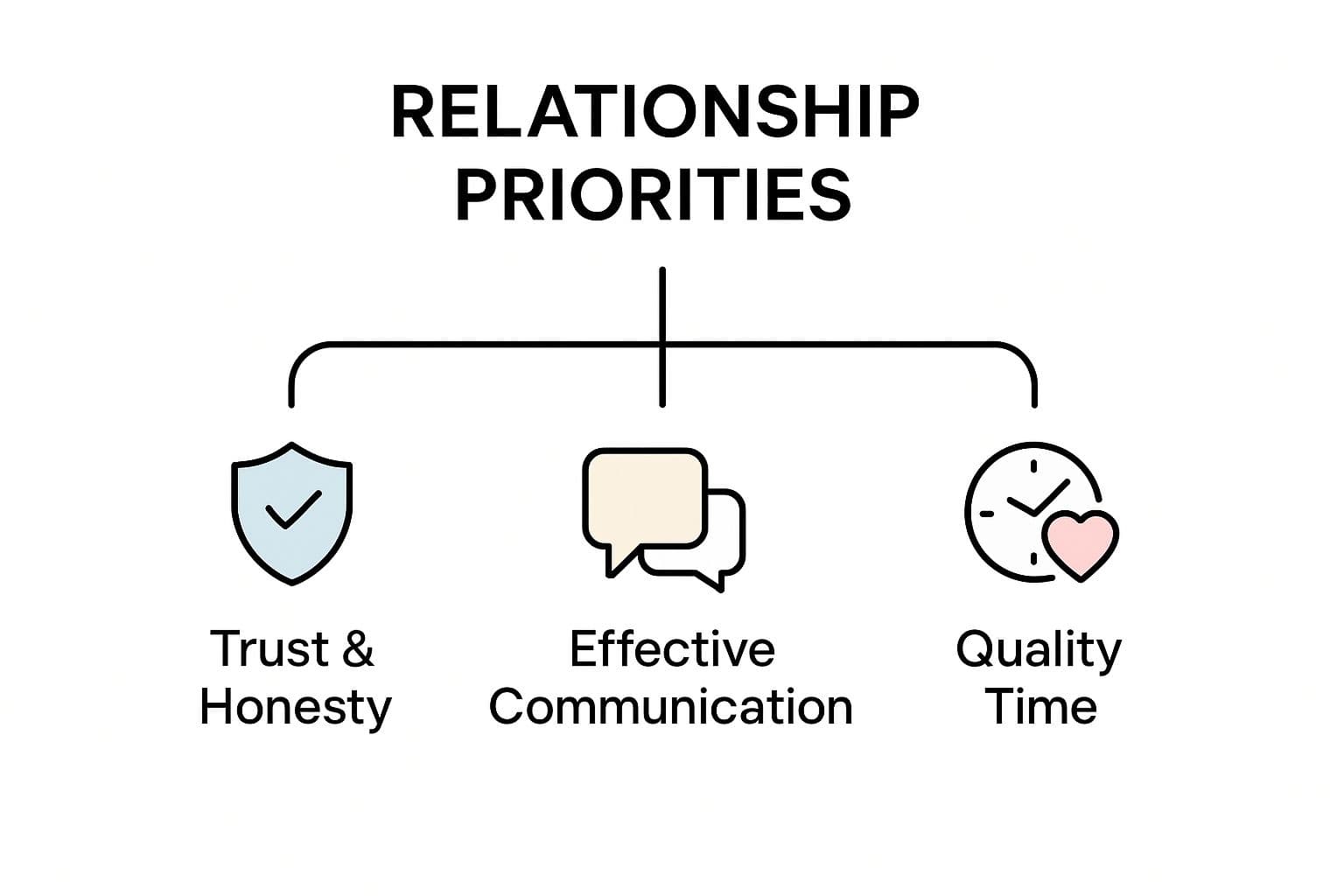When you remove the noise, the core priorities in a lasting relationship are simple and actionable: trust, honest communication, shared values, and mutual respect. Think of these as a flexible framework you build together—daily actions that help your bond grow stronger over time.
September 29, 2025 (2mo ago) — last updated November 2, 2025 (1mo ago)
Top Relationship Priorities for Lasting Love
Learn the core priorities—trust, communication, shared values, mutual respect—and practical steps to build a lasting, healthy relationship.
← Back to blog
Top Relationship Priorities for Lasting Love
Summary: Discover the essential priorities in a relationship that build a strong, lasting bond. Learn what truly matters for a healthy and successful partnership.
Introduction
When you remove the noise, the core priorities in a lasting relationship are simple and actionable: trust, honest communication, shared values, and mutual respect. Think of these as a flexible framework you build together—daily actions that help your bond grow stronger over time.
What Are the True Priorities in a Relationship
Trying to figure out what truly matters in a partnership can feel like navigating a maze. It’s easy to get sidetracked by what society, movies, or friends tell us a relationship should be. But the foundation of a healthy connection is much simpler.
A helpful image is to think of a relationship as a garden. It’s a living thing that needs consistent care to flourish. This shifts the focus from “what am I getting?” to “what are we growing together?” It’s a conscious decision to co-create something beautiful, where both people actively nurture the bond.
The Foundational Pillars
At its core, a strong relationship rests on a few key pillars. These aren’t just romantic buzzwords; they are the active, non-negotiable ingredients for a deep connection. Without them, even passionate romance can struggle under pressure.
The most essential priorities are:
- Trust and Honesty: The bedrock of vulnerability and emotional safety.
- Effective Communication: More than talking—creating a space to truly hear and understand one another.
- Quality Time: Intentionally carving out focused, uninterrupted time for each other.

These pillars are things you do every day. Building on them lets you set clear expectations and respect individual needs, which is where boundaries come into play. For practical examples, see the healthy relationship boundaries guide linked below.
Core Pillars at a Glance
| Priority | Why It Matters |
|---|---|
| Trust & Honesty | Creates a safe space for vulnerability and emotional security. |
| Open Communication | Helps partners navigate conflict and express needs without misunderstanding. |
| Mutual Respect | Acknowledges individuality and prevents contempt. |
| Quality Time | Strengthens emotional connection and signals that the relationship is a priority. |
| Shared Values | Provides direction and keeps both partners working toward a similar future. |
How Modern Relationships Have Changed
The old playbook of two people becoming one is fading. Today, relationships often balance individual growth alongside shared goals. Personal well-being, independence, and pursuing a purpose are now seen as assets to a partnership, not threats.

A recent global EY Gen Z survey of young adults highlighted that financial independence and staying true to oneself rank highly among life goals, often above being in a relationship1. That same shift shows people want partnerships that allow personal growth.
The New Rules of Engagement
Consider a couple like Alex and Jamie: each has demanding ambitions but makes the partnership a priority by championing one another’s goals. Quality time can look like brainstorming or practicing for a presentation, not only romantic dinners. When one partner wins, they both win.
This mindset relies on a few principles:
- Interdependence over codependence: Maintain identities while choosing to support one another.
- Celebrating individual passions: Your partner is your biggest cheerleader for personal wins.
- Flexible timelines: Milestones like marriage or buying a house happen on your schedule, not society’s.
Pulling this off requires honest conversations and clear understanding of what makes both partners feel fulfilled.
How to Define Your Personal Relationship Blueprint
Knowing what you want is the first step to building a relationship that fits you. This goes deeper than a checklist—it’s a personal blueprint built around your emotional and psychological needs.
Think of it like designing a custom house: you plan non-negotiables first. Your relationship blueprint helps you understand what you naturally bring to a partnership and what you need to feel whole.
Discovering Your Core Needs with a Proven System
Tools for self-discovery can speed this process. Dan Millman’s book The Life You Were Born to Live and the Life Purpose App offer one such framework for identifying strengths and challenges based on your birth date3. That insight can clarify your non-negotiables and reduce guesswork.
Knowing your tendencies helps you answer:
- What are my natural strengths in relationships?
- What recurring challenges do I face?
- What do I truly need to feel fulfilled?
Questions to Build Your Blueprint
Your blueprint is a living document. Use these prompts to begin:
- When did I feel most alive and supported in past relationships? What was happening?
- What frustrations keep showing up, and what need was unmet?
- What qualities make me feel genuinely safe and respected?
- On an average Tuesday, how do I want to feel in my partnership? (Peaceful, inspired, secure, playful, etc.)
Use these answers to guide conversations with your partner and refine your shared priorities.
Communicating Your Priorities With Your Partner
Figuring out your priorities is only half the work. The other half is sharing them and learning your partner’s. Great communication means creating a space where honesty feels safe and vulnerability is respected.

A current dating trend—being explicit about relationship goals early—reduces wasted emotional energy and creates better alignment from the start4.
Creating Space for Honest Conversations
Set aside regular check-ins, like a monthly “state of the union” over coffee. These are low-pressure windows to ask what’s working, what’s challenging, and how priorities are shifting.
Use “I” statements to express needs without assigning blame. For example, say: “I feel disconnected when we don’t get much quality time together,” rather than: “You never make time for me.” Improving communication skills is an ongoing investment.
Navigating Disagreements When Priorities Clash
Differences are normal. Practice active listening: listen to understand, summarize what you heard, and find the shared value under the disagreement. For example, a clash over saving versus travel often masks a deeper conflict between security and freedom. Work creatively to honor both needs, such as creating separate savings and travel funds.
Nurturing Emotional and Physical Intimacy
Intimacy combines emotional depth and physical closeness. Emotional intimacy is the root; physical intimacy is the fruit. Both matter—global data links partner satisfaction to romantic and sexual satisfaction across cultures2.
Building a Holistic Connection
Small, consistent habits deepen both sides of intimacy:
- Daily emotional check-ins: Ask, “How are you really doing?” and listen without fixing.
- Non-sexual physical touch: Hugs, holding hands, or a shoulder squeeze throughout the day.
- Dedicated connection time: Put phones away and prioritize distraction-free moments.
These practices build emotional intelligence and reinforce the foundation of your partnership.
Building a Lasting Partnership Day by Day
Strong relationships are built one choice at a time. The real magic happens in small, consistent efforts—the tiny deposits into your shared emotional bank account.

A framework like the one in The Life You Were Born to Live or an app like the Life Purpose App can clarify your needs, but the work continues in daily habits and mutual practice of healthy relationship behaviors.
Your Guiding Principles
Adopt these daily non-negotiables:
- Practice intentional connection: Make quality time happen, especially when life is busy.
- Communicate with curiosity: Listen to understand rather than to plan a reply.
- Embrace evolution: Give each other space to grow and adjust shared priorities accordingly.
The most resilient partnerships aren’t free of storms; they’re built to weather them.
Q&A — Quick Answers to Common Questions
What if my partner and I have different priorities?
Different priorities are normal. Get curious about the reasons behind each priority, identify shared underlying values, and design solutions that honor both needs rather than declaring a winner.
How often should we revisit our priorities?
Treat priorities as living things. Schedule a check-in every 6 to 12 months and revisit them after major life changes like a new job, move, or family addition.
Can tools like a life path number actually help?
Yes. Self-discovery tools can clarify your strengths and recurring challenges, helping you communicate needs more clearly and build a relationship aligned with who you are.
For practical resources mentioned above, see:
- Healthy relationship boundaries examples: https://lifepurposeapp.com/blog/healthy-relationship-boundaries-examples
- How to improve communication skills: https://lifepurposeapp.com/blog/how-to-improve-communication-skills
- Emotional intelligence in relationships: https://lifepurposeapp.com/blog/emotional-intelligence-in-relationships
- Life Purpose App: https://lifepurposeapp.com
Discover Your Life Purpose Today!
Unlock your true potential and find your life’s purpose.
